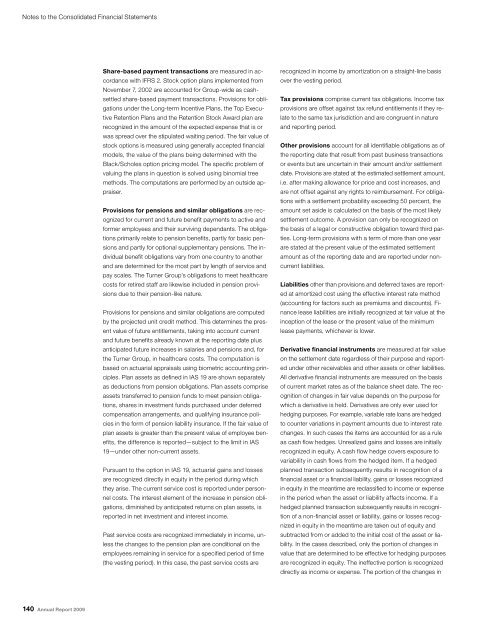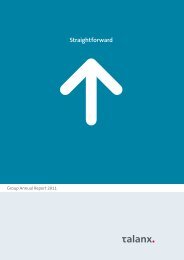ONE ROOF
ONE ROOF
ONE ROOF
Create successful ePaper yourself
Turn your PDF publications into a flip-book with our unique Google optimized e-Paper software.
Notes to the Consolidated Financial Statements<br />
140 Annual Report 2009<br />
Share-based payment transactions are measured in ac-<br />
cordance with IFRS 2. Stock option plans implemented from<br />
November 7, 2002 are accounted for Group-wide as cashsettled<br />
share-based payment transactions. Provisions for obligations<br />
under the Long-term Incentive Plans, the Top Executive<br />
Retention Plans and the Retention Stock Award plan are<br />
recognized in the amount of the expected expense that is or<br />
was spread over the stipulated waiting period. The fair value of<br />
stock options is measured using generally accepted financial<br />
models, the value of the plans being determined with the<br />
Black/Scholes option pricing model. The specific problem of<br />
valuing the plans in question is solved using binomial tree<br />
methods. The computations are performed by an outside appraiser.<br />
Provisions for pensions and similar obligations are rec-<br />
ognized for current and future benefit payments to active and<br />
former employees and their surviving dependants. The obligations<br />
primarily relate to pension benefits, partly for basic pensions<br />
and partly for optional supplementary pensions. The individual<br />
benefit obligations vary from one country to another<br />
and are determined for the most part by length of service and<br />
pay scales. The Turner Group’s obligations to meet healthcare<br />
costs for retired staff are likewise included in pension provisions<br />
due to their pension-like nature.<br />
Provisions for pensions and similar obligations are computed<br />
by the projected unit credit method. This determines the present<br />
value of future entitlements, taking into account current<br />
and future benefits already known at the reporting date plus<br />
anticipated future increases in salaries and pensions and, for<br />
the Turner Group, in healthcare costs. The computation is<br />
based on actuarial appraisals using biometric accounting principles.<br />
Plan assets as defined in IAS 19 are shown separately<br />
as deductions from pension obligations. Plan assets comprise<br />
assets transferred to pension funds to meet pension obligations,<br />
shares in investment funds purchased under deferred<br />
compensation arrangements, and qualifying insurance policies<br />
in the form of pension liability insurance. If the fair value of<br />
plan assets is greater than the present value of employee benefits,<br />
the difference is reported—subject to the limit in IAS<br />
19—under other non-current assets.<br />
Pursuant to the option in IAS 19, actuarial gains and losses<br />
are recognized directly in equity in the period during which<br />
they arise. The current service cost is reported under personnel<br />
costs. The interest element of the increase in pension obligations,<br />
diminished by anticipated returns on plan assets, is<br />
reported in net investment and interest income.<br />
Past service costs are recognized immediately in income, un-<br />
less the changes to the pension plan are conditional on the<br />
employees remaining in service for a specified period of time<br />
(the vesting period). In this case, the past service costs are<br />
recognized in income by amortization on a straight-line basis<br />
over the vesting period.<br />
Tax provisions comprise current tax obligations. Income tax<br />
provisions are offset against tax refund entitlements if they relate<br />
to the same tax jurisdiction and are congruent in nature<br />
and reporting period.<br />
Other provisions account for all identifiable obligations as of<br />
the reporting date that result from past business transactions<br />
or events but are uncertain in their amount and/or settlement<br />
date. Provisions are stated at the estimated settlement amount,<br />
i.e. after making allowance for price and cost increases, and<br />
are not offset against any rights to reimbursement. For obligations<br />
with a settlement probability exceeding 50 percent, the<br />
amount set aside is calculated on the basis of the most likely<br />
settlement outcome. A provision can only be recognized on<br />
the basis of a legal or constructive obligation toward third parties.<br />
Long-term provisions with a term of more than one year<br />
are stated at the present value of the estimated settlement<br />
amount as of the reporting date and are reported under noncurrent<br />
liabilities.<br />
Liabilities other than provisions and deferred taxes are report-<br />
ed at amortized cost using the effective interest rate method<br />
(accounting for factors such as premiums and discounts). Finance<br />
lease liabilities are initially recognized at fair value at the<br />
inception of the lease or the present value of the minimum<br />
lease payments, whichever is lower.<br />
Derivative financial instruments are measured at fair value<br />
on the settlement date regardless of their purpose and reported<br />
under other receivables and other assets or other liabilities.<br />
All derivative financial instruments are measured on the basis<br />
of current market rates as of the balance sheet date. The recognition<br />
of changes in fair value depends on the purpose for<br />
which a derivative is held. Derivatives are only ever used for<br />
hedging purposes. For example, variable rate loans are hedged<br />
to counter variations in payment amounts due to interest rate<br />
changes. In such cases the items are accounted for as a rule<br />
as cash flow hedges. Unrealized gains and losses are initially<br />
recognized in equity. A cash flow hedge covers exposure to<br />
variability in cash flows from the hedged item. If a hedged<br />
planned transaction subsequently results in recognition of a<br />
financial asset or a financial liability, gains or losses recognized<br />
in equity in the meantime are reclassified to income or expense<br />
in the period when the asset or liability affects income. If a<br />
hedged planned transaction subsequently results in recognition<br />
of a non-financial asset or liability, gains or losses recognized<br />
in equity in the meantime are taken out of equity and<br />
subtracted from or added to the initial cost of the asset or liability.<br />
In the cases described, only the portion of changes in<br />
value that are determined to be effective for hedging purposes<br />
are recognized in equity. The ineffective portion is recognized<br />
directly as income or expense. The portion of the changes in
















